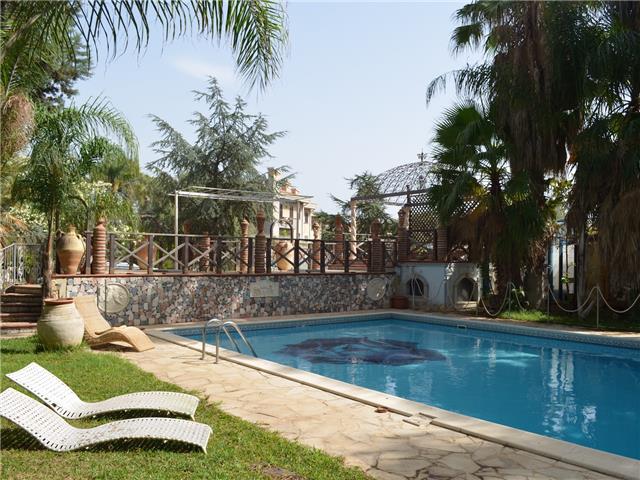A short history of Bronte
by Bruno Luigi Spedalieri
Sydney 1993
Introduction
For 24 years now I have been conducting historical and genealogical researches on the subject of my Family and the City of Bronte in Sicily. My findings are the result of a lengthy analysis of a lot of historical books, in particular: “Storia di Bronte” by Father Gesualdo De Luca, and “Memorie Storiche di Bronte” by Benedetto Radice.
But most of all are the result of direct examination of the Bourbon Archives and the Parish Archives of Bronte in Sicily, conducted between 1978 and 1981 by my father Gioacchino Francesco Spedalieri first and by myself, after his death in 1982. Precious information I could obtain also by consulting the reference department of the State Library of New South Wales, where I discovered how the name of Bronte in Sicily was adopted by other countries and other people. In fact, five different localities in the world are called Bronte: two in Australia, New South Wales and Tasmania, one in Canada on the Lake Ontario, one in Texas USA and one in the southern island of New Zealand. All these names originated from Bronte in Sicily. And the famous English writers: Anne, Emily and Charlotte Brontë themselves derived their family name from Bronte in Sicily. Both my parents were born and died in Bronte Sicily, and in 1973 when I came to Australia I was surprised to find the name of Bronte in these shores so far away from my country. I decided then to continue my study and my researches here in Australia.
In 1987 a suggestion was presented to the Municipal Council of Waverley to suppress the name of Bronte together with those of Tamarama and Mill Hill to create a new unified suburb named Waverley.I was one of the protesters against the proposal, I did send a letter giving the reason for my opposition. Finally the decision to keep those names prevailed.
Bronte in Sicily
The City of Bronte in Sicily is situated on the west side of the volcano Etna at 794 meters above sea level, between the cities of Adrano and Randazzo. It is one of the 53 communes of Catania Province. The light train of the private Company Circumetnea connects Bronte with Catania, the Capital city of the Province, 55 kilometers South, and Giarre 58 kilometers North, together with a number of other towns lying on the slopes of the volcano.
Bronte is essentially rural city renown for the pistachio nuts. Bronte’s territory is the only place in Italy where this precious nut is cultivated; it was imported by the Arabs in the 9th century. Recently on the territory of Bronte was discovered the methane gas and some petrol. Its population has been stationary for the last four decades due to the massive postwar migration and the creation of Maniace Municipality.
The Origin
The City of Bronte was founded by a group of Greek Soldiers from Athens around the year 413 B.C. The name was taken from the Greek Mythology, it means Thunder and was the name of one of the Cyclops, believed to live inside the Volcano Etna. The Founders dedicated a temple to their protective Goddess Athena.
In 1927, in the territory of the city were discovered some Greek coins showing the head of the Greek Goddess Athena, which confirms this theory. With the advent of the Roman Civilization, the Temple’s name was changed in that of Minerva. Later on, the Christians dedicated the same temple to the Virgin Mary, calling it: The Church Santa Maria of Minerva. Today it is the Mother Church of the City of Bronte and is dedicated to the Holy Trinity.
Bronte 25,000 hectares territory is surrounded by the immense Etna Park on the east side and extends down the valley to the Simeto River on the West. The population number varies between 20,000 and 26,000 according to the way it is counted: strictly residents only or all people provided with resident status, some of which are actually working and living outside the territory.
First historical documents
During its long history Bronte was subjected, like all Sicily, to invasions and occupations from the Greeks in the 8th century before Christ, and the Romans in the 3rd century BC first, then during the Christian Era, invasions from the Byzantines of the East, from the Sarazins of the South, from the Normans of the North and from the Aragoneses of the West. The Arab occupation of Sicily lasted over 200 years from the 827 to the year 1091.
Since the beginning of the second millennium, the territory of Bronte was claimed as own property by the neighboring Benedictine Monks of Maniace’s Abbey Santa Maria, and the citizens were bound to pay heavy taxes to their masters.
In 1491 the Cardinal Rodorigo Borgia, Abbot of Maniace’s Abbey and future Pope Alexander VI, donated the territory of Bronte to the Pope Innocent VIII. The Pope, on his turn, elected as the beneficiary of the offer the New Hospital of Palermo. In so doing the Pontiff put the territory of Bronte in the hand of the King of Sicily. The people of Bronte did protest but were unable to reverse the situation.
Bronte Duchy of Horatio Nelson
In 1799 Ferdinand IV of Naples and Sicily saw a good opportunity to get rid of the problematic Dominion. The British Admiral Horatio Nelson, in June of that year, had helped the King to fight and win the French aggression against Naples. The Kingdom was saved and the Throne also. As a reward, on the 13 August 1799, the birthday of Queen Caroline, the King conferred to the Admiral the title of Duke, (Royal Secretariat of Palermo Doc. N. 4178, File N. 27), and made him the owner of the Dominion of Bronte with all the properties and dependencies. Bronte itself was elevated to the title of Duchy on the 10 October 1799, (State Archives of Palermo, the Year 1799-1800, Vol. 7, File 1-5).The people of Bronte, who had never accepted any previous feudal masters, reacted strongly against the new Duke. Horatio Nelson, on his part, had never and would never set foot in Bronte, his Feudal Territory. The Duchy Nelson of Bronte lasted 7 generations. At the death of the Admiral (1805), the Duchy passed to his brother Reverend William Nelson (1805-1835), then to Dame Charlotte Marie (1835-1874), the daughter of William, married to Samuel 2nd Baron of Bridport. From them, the Duchy passed to their eldest son General Alexander 1st Viscount and 3rd Baron Bridport (1874-1904), and from him to his son Honorable Sir Alexander Nelson Hood (1904-1937). From Sir Alexander, the Duchy passed to his nephew Lieutenant Commander 3rd Viscount and 5th Baron Bridport (1937-1969). Alexander Nelson Hood Junior, the son of the Lieutenant was the 7th and the last Duke of Bronte (1969-1980).The Duke Alexander Nelson Hood Junior in 1977 at the age of 28 decided to sell the properties of Bronte. The vast rural land was partitioned and sold to the peasants of Maniace.The Castle, the surrounding garden and the ancient Abbey Santa Maria were acquired by the Council of Bronte. All the contracts were signed by the beginning of 1980 and since then Maniace has become an independent municipality.
Bronte in the world
Ironically it was that ambiguous promotion of Admiral Horatio Nelson that made Bronte renown to the world. In the middle of 1800, in honor of the Admiral, the name of Bronte was given to a vast property acquired by the barrister and politician Robert Lowe 1st Viscount of Sherbrooke, in New South Wales, Australia, in the eastern shores of Sydney.
The same name of Bronte was given to an extensive property, situated in the center of Tasmania, purchased by Lieutenant Arthur Corbett between 1834 and 1863. Lieutenant Corbett was married to a relative of Lady Emma Hamilton, the mistress of Duke Horatio Nelson, and in honor of the great Admiral he gave to the property the name of Bronte Park. Again in Canada, in the Shire of Oakville, the name of Bronte was given, in honor of the Admiral, to a little center planted on the shores of Lake Ontario in 1833. And also in his honor were named the City of Trafalgar, Bronte Creek, and Bronte Harbour. It was under the pressure of the settler William Chisholm, who in 1827 had bought acres of land at the mouth of the Sixteen Mile Creek, that on 30 December 1833 William Hawkins submitted to the Surveyor-General plans for a new town. On 19 August 1834, the name of the new town did appear, for the first time, as “Bronti” in the Upper Canada Gazette. In Irland, in 1800, Patrick Prundy, the grandfather of the famous English Writers: Anne, Emily, and Charlotte, in honor of Admiral Nelson decided to change his family name in that of Brontë. Scrupulously he added a dieresis on the last vowel to preserve the correct Italian pronunciation. In Texas, 50 kilometers north of San Angelo, a little town was built in 1888. It was called Bronte in honor of the English writer Charlotte Bronte. The name was preferred to that of Bronco. In 1906 the timber houses of the old Bronte were moved half-mile northeast to be placed near the east-west railway, which was under construction.
In New Zealand, on the extreme north of the southern island, near the city of Nelson, a little town is called Bronte.
The Virgin Annunciate patron of Bronte
It is documented in a census conducted by the Emir of Catania, during the Arab occupation of Sicily, that in 830 of our era Bronte counted 994 Muslims and 664 Christians, a total of 1658 people (Airoldi Vol 1, page 291: The population in Sicily).
By 1535 the population had dropped as low as 250 souls, due to some natural events: earthquakes and volcanic eruptions, but mostly caused by plagues and famine. Many people had died and many others had left the unsafe center and taken refuge into poor hamlets in the midst of the etnean woods.
In October 1535 Emperor Charles V, in his way back from a campaign against the Turks in Tunisia, visited Bronte. He was surprised and shocked at the miserable situation of those poor people. He decided then that all the people living dispersed in the neighboring hamlets should go back to their original center of Bronte.
To promote the unification the Emperor left in the little center his friend and councilor Noble Nicola Spedalieri, son of Joaquin of the Hospitallers of Saint John in Jerusalem, Earl of Cessole in North of Italy. Also, he sent a letter of recommendation to the Governor of Randazzo, under which jurisdiction was placed the Territory of Bronte: “Commendo tibi tuguria Brontis”.
The Noble Nicola Spedalieri, contravening the suggestions of the Government of Randazzo, refused to use constriction to achieve the goal set by the Emperor, he trusted instead the deep religious feelings of the brontese people.
In 1540 Nicola Spedalieri went to Palermo and commissioned from the renown Sicilian sculptor Antonino Gagini a group of statues in marble representing the Annunciation of the Virgin Mary.
The contract was signed the 21st January 1540 in the office of Notary Giacomo Dimitri (Mons. Gioacchino Di Marzo: I Gagini e la Scultura in Sicilia). The price was agreed at 48 ounces, which were the equivalent of 100,000 Euros at today conversion. The statues arrived in Bronte in 1543 and since their arrival, many prodigies were reported. Attracted by the miraculous images, the people of the surrounding hamlets started moving toward the center. By 1548 the population of Bronte had reached the number of 2815 souls (Census by the Viceroy De Vega).
 PaciniPacini House is an apartment located in the heart of Catania, on the second floor of an ancientpalace. The house consists of a bright, air-conditioned living room, a kitchen, a […] Book Now
PaciniPacini House is an apartment located in the heart of Catania, on the second floor of an ancientpalace. The house consists of a bright, air-conditioned living room, a kitchen, a […] Book Now Villa Rubino – Wonderful house with private pool in CataniaVilla Rubino is Immersed in a park with many olive trees bordering a beautiful and artistic Via Crucis made by the famous ceramist of Caltagirone G. Cultrera, the house is […] Book Now
Villa Rubino – Wonderful house with private pool in CataniaVilla Rubino is Immersed in a park with many olive trees bordering a beautiful and artistic Via Crucis made by the famous ceramist of Caltagirone G. Cultrera, the house is […] Book Now








